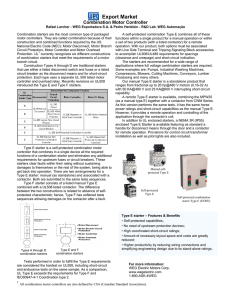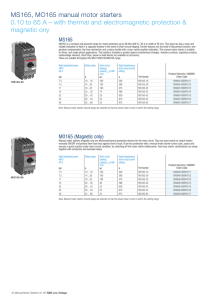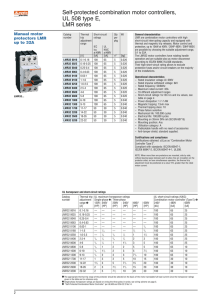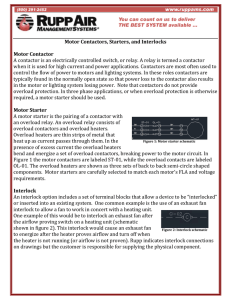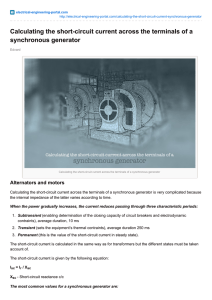Development of Compact Combination Starter Series
advertisement
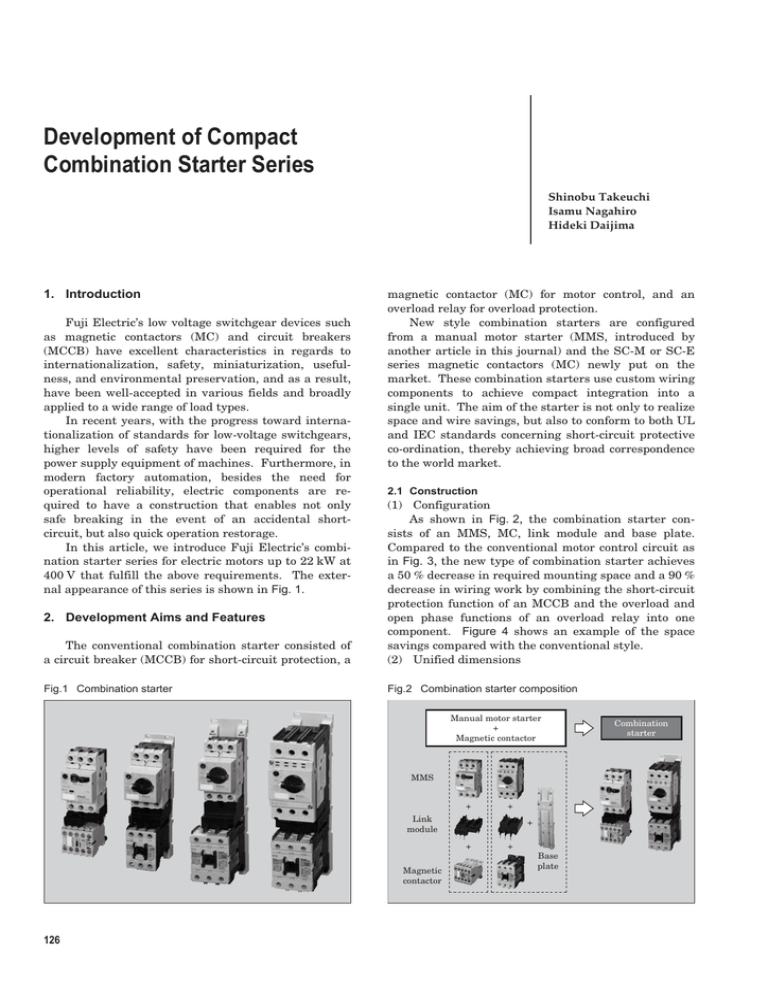
Development of Compact Combination Starter Series Shinobu Takeuchi Isamu Nagahiro Hideki Daijima 1. Introduction Fuji Electric’s low voltage switchgear devices such as magnetic contactors (MC) and circuit breakers (MCCB) have excellent characteristics in regards to internationalization, safety, miniaturization, usefulness, and environmental preservation, and as a result, have been well-accepted in various fields and broadly applied to a wide range of load types. In recent years, with the progress toward internationalization of standards for low-voltage switchgears, higher levels of safety have been required for the power supply equipment of machines. Furthermore, in modern factory automation, besides the need for operational reliability, electric components are required to have a construction that enables not only safe breaking in the event of an accidental shortcircuit, but also quick operation restorage. In this article, we introduce Fuji Electric’s combination starter series for electric motors up to 22 kW at 400 V that fulfill the above requirements. The external appearance of this series is shown in Fig. 1. magnetic contactor (MC) for motor control, and an overload relay for overload protection. New style combination starters are configured from a manual motor starter (MMS, introduced by another article in this journal) and the SC-M or SC-E series magnetic contactors (MC) newly put on the market. These combination starters use custom wiring components to achieve compact integration into a single unit. The aim of the starter is not only to realize space and wire savings, but also to conform to both UL and IEC standards concerning short-circuit protective co-ordination, thereby achieving broad correspondence to the world market. 2.1 Construction The conventional combination starter consisted of a circuit breaker (MCCB) for short-circuit protection, a (1) Configuration As shown in Fig. 2, the combination starter consists of an MMS, MC, link module and base plate. Compared to the conventional motor control circuit as in Fig. 3, the new type of combination starter achieves a 50 % decrease in required mounting space and a 90 % decrease in wiring work by combining the short-circuit protection function of an MCCB and the overload and open phase functions of an overload relay into one component. Figure 4 shows an example of the space savings compared with the conventional style. (2) Unified dimensions Fig.1 Combination starter Fig.2 Combination starter composition 2. Development Aims and Features Manual motor starter + Magnetic contactor Combination starter MMS + + Link module + + Magnetic contactor 126 + Base plate Vol. 49 No. 4 FUJI ELECTRIC REVIEW Fig.3 Conventional and new systems for motor control Conventional system New system using an MMS MCCB · · · · · · · · · · · · · · · · · · · · · · · MCCB · · · · · · · · · · · · · · · · · · · · Combination starter · · · (MMS + Contactor) ™Short-circuit protection ™Short-circuit protection ™Overload protection ™Phase-loss protection Contactor + Motor · · · · · · · · · · · · · · · · MCCB · · · · · · · · · · · · · · · · Thermal overload relay ···· ™Overload protection ™Phase-loss protection Motor · · · · · · · · · · · · · · · · Fig.4 Space savings Mounting space : ▲52 % Wiring work : ▲90 % The MC width of 43, 45, 54 or 67 mm is unified with the MMS width of 45 or 55 mm in order to attain a slim and unified appearance and also to promote an industrial standard form factor. (3) Modularizing and block assembly system Accessories for the MC and MMS are constructed as modularized blocks, and can be attached later according to the customers needs. 2.2 Conformity to global standards (1) Trend for short-circuit protective co-ordination In the conventional JIS and JEM standards for MCs, there was no regulation of short-circuit protective co-ordination, and generally an MC would be replaced after the occurrence of a short-circuit accident. The only regulation prescribed was by JEM1195, and this concerned the damage level of the MC after a short-circuit in a combined MCCB and MC apparatus. But this regulation was limited in scope to specific fields, such as motor control centers, and a general customer could not use it as a standard for apparatus selection. On the other hand, IEC and UL had regulations Development of Compact Combination Starter Series Mounting space 52 % reduction Wiring work 90 % reduction For control panel For control panel such as “co-ordination with short-circuit protective device” for MCs (IEC60947-4-1) and “combination motor controllers” (UL508) to identify and rank the short-circuit protective co-ordination for component combinations. Both regulations clarify the combination performance level of the MCCB and MC and assess damage and reusability after breaking the short-circuit current for the MCCB, overload relay and MC apparatuses. This has enabled the general user to select protective devices having higher levels of safety and reliability. (2) Conformance to IEC standard In the “co-ordination with short-circuit protective device” for MCs of the IEC60947-4-1 standard, there are two types of ratings for breaking a short-circuit, “r”, which is specified by the standard and “Iq”, which the manufacture will assure. Also, there are two types of protection levels defined as “type 1” and “type 2”. A “type 1” combination accepts that, under short-circuit conditions, the MC may sustain damage and require partial or complete replacement for further service. The contacts of a “type 1” MC are permitted to be welded. On the other hand, a “type 2” combination must be capable of continuous service, without requiring replacement or sustaining damage except light welding of the contacts of the MC. Conventionally, “type 2” short-circuit protective co-ordination had been attained only by the combination of an MC and a fuse. But now, Fuji Electric’s new combination starter (consisting of an MMS and MC) has achieved “type 2” protection at 400 V for a 50 kA short-circuit current. The reasons why these combination starters achieved such high performance are because: (1), the MMS is developed with excellent breaking performance so that arc energy is minimized during the short-circuit and (2), return spring force, contact pressure and the 127 Table 1 UL508 Part 4 - Construction type of combination motor controllers Device Type Manual disconnect A Fuse C D E F Disconnect UL98 or UL1087 ○ UL508 Overload relay UL508 UL508 Magnetic contactor or solid state contactor UL508 Overload relay UL508 Inverse-time circuit breaker UL489 Magnetic contactor or solid state contactor UL508 Overload relay UL508 ○ ○ ○ ○ ○ ○ ○ ○ ○ ○ Instantaneous-trip circuit breaker UL489 UL508 Overload relay UL508 Self-protected control device UL508 ○ ○ Manual self-protected combination controller UL508 ○ ○ Magnetic contactor or solid state contactor UL508 Motor capaicty (kW) Iq= 50 kA at 400 V AC 0 5 10 15 20 25 Type-1 BM3RSB-010 SC-M02 BM3RSB-004 4 kW 1.1 kW Type-1 SC-M01 Type-2 Type-1 BM3RHB-025 SC-E05 BM3RSB-020 11 kW 7.5 kW Type-2 SC-E05 Type-2 Type-1 BM3VHB-050 SC-E2S BM3VHB-040 22 kW 18.5 kW SC-E2 Type-2 Motor overload ○ Magnetic contactor or solid state contactor Fig.5 Short-circuit protective co-ordination types and the component combinations of combination starters, for the corresponding motor capacity Motor control ○ UL98 or UL1087 Fuse Branch circuit protection ○ UL248 series Magnetic contactor or solid state contactor Manual disconnect B Component function Corresponding standard ○ ○ ○ ○ ○ ○ Formerly, in North America, there were regulations (defined as type A to type D) for the conventional apparatuses of fuses, MCCBs and MCs in motor protection circuits. In recent years, new types of combination apparatuses, “type E” and “type F”, were established based on the national electric code (NEC). Table 1 lists the construction type of the components for the motor control and protection apparatus according to UL508. As indicated in Table 1, “type F” enables the use of UL508 components, which have satisfied additional structural and short-circuit protection requirements, to completely configure the apparatus. Since the UL489 MCCB can be omitted as branch circuit protection in the motor control circuit, the range of MMS application to motor control and protection can be expanded. (Note: This omission is only applicable to motor circuits.) Fuji Electric’s combination starter has been developed based on these trends, and accordingly, the combination of MC and MMS conforms to IEC and UL standard regulations. (IEC 60947-4-1 7.2.5) 3. Conclusion contact material of the MC are designed in accordance with the short-circuit breaking performance of the MMS. This means that characteristics such as “shortcircuit breaking time”, “short-circuit let through I 2t” and “contact bounce time of the MC” are considered in the design to achieve the total performance. See Fig. 5 for a summary of co-ordination type and the combination of components for the corresponding motor capacity. (3) UL standard 128 In this article, we have presented an overview of Fuji Electric’s combination starter that consists of an MC and MMS. The combination starter is a product that incorporates many years of Fuji Electric’s diverse experiences and accumulated technology in the development of MCs and MCCBs. We intend to continue to strive for further improvement, to endeavor to meet the demands of the market, and to continue supplying high quality and high technology products. Vol. 49 No. 4 FUJI ELECTRIC REVIEW

